Bruce Broughton: The Great Prince of Bambi II‘s Music
by Jeremie | April 4, 2008 6:30 am
In a traditional cartoon, animation and music are so intricately intertwined that you can’t talk about one without talking about the other. One of the greatest specialists in animation and film music of our times, Bruce Broughton knows exactly how to compose music that perfectly fits the picture, and adds to it. But more than that, his extensive musical culture allowed him to effectively create a bridge between the original 1942 classic Bambi and the 2006 “midquel”, exactly as were the very wishes of director Brian Pimental.
Born March 8 1945, Bruce Broughton has distinguished himself in animation music scoring (The Rescuers Down Under, Tiny Toons Adventures, with a clear and knowing nod to Carl Stalling’s style), live-action (Silverado, evoking the big, traditional western scores of the 50s), television (Eloise at Christmastime, inspired by both Gershwin and Tchaikovsky) and concert music. Because of his impressive versatility, he’s used to sharing his experience with students, be it as a film composition teacher in the Advanced Film Music Studies program at USC or through lectures at UCLA.
Now, the Master speaks to us, revealing all about the musical history of Bambi through the making of Bambi II…
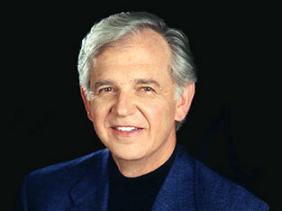
Animated Views: How did you come on to the Bambi II project?
Bruce Broughton: It was a result of the good reception I got at Disney from [Mickey, Donald, Goofy:] The Three Musketeers score. Brian Pimental, the director, attended some of the Musketeers sessions and then asked me to work on Bambi II.
AV: How did you work with director Brian Pimental?
BB: We got along fine. Brian is a very talented guy, and this was his first job as a director. He made a first-rate movie that is quite sensitive to the first film. He had very strong ideas about what he wanted musically and dramatically. He wanted the score to sound like the original Bambi. His idea was that one should be able to watch the original and then watch our new film and not feel any change in style, either visual or musical. He was, during the process of scoring, very specific about what he wanted.
AV:How would you describe the music of this film?
BB: The style of the music in Bambi II is very much based upon the style of the original. It’s very fluid harmonically, full of little themes and tunes in the style of Frank Churchill, and dramatically not unlike much of the very contemporary music in the original.
AV:How do you feel about the fact of working on the “midquel” of such a classic?
BB: This film really is a “midquel”, in that it begins after the death of Bambi’s mother. One could watch the original up to that point, then start watching this film; and then, after Bambi II was finished, one could resume watching the original. I had no problem working on such a film. The characters and the story are very much a part of elements implied in the original movie. The voices are very similar. Actually, to me, the story in Bambi II is better than the original.
AV:Were you a fan of the original film?
BB: I saw the original film around 1948. When Bambi’s mother died, I was the one who was blown away. I was in shock (I was about three years old, and was watching it with my mother beside me). I apparently recovered enough to play the Shirley Temple-narrated 78 rpm recordings of the soundtrack over and over and over again on a little record player I had. I got to know all of the famous lines very well, so that when I finally saw the film as an adult – shortly before I worked on The Rescuers Down Under – I remembered most of the dialogue very well, like Thumper’s saying, “If you can’t say somethin’ nice, don’t say nothin’ at all.” These words were embedded in my memory since childhood. I didn’t like the movie as much as, say, Pinocchio, but it played a big part in my very young movie-going experience.

AV:You integrated some themes from the original 1942 film. How did you approach that?
BB: Brian was very specific as to what he wanted to use from the original film. Bambi II had a substantial temp-track, much of it culled from the original score, and occasionally Brian would say, “I want that there!” It didn’t create huge problems for me. The Frank Churchill themes are so good and so strong – and they are from Bambi – that it never seemed inappropriate to use them. Having said that, with the exception of Love Is a Song, which is referred to perhaps three times in the score, and a couple of other minor themes – one for the skunk Flower, for instance (though it wasn’t originally Flower’s theme), and one in which the groundhog (voiced by Brian) sings one of the original songs – all of the dramatic themes are mine. I have new themes for Thumper, for Bambi and for Ronno which are referenced throughout the score. The theme we used for Flower was, by the way, not the original Flower theme. It was called the Walking Theme in the original, but it’s vintage Churchill and works great in this movie.

AV:How did you make reference to the musical style of the 1942 score?
BB: The 1942 style is most apparent in the scenes with Thumper. In most of the non-dramatic scenes, the scenes that don’t include the Great Prince, the music often has the old-fashioned flavor.
AV:What elements from the period did you mostly take your inspiration from?
BB: Everything. The original score was done by three or four guys, and they were very well trained. The music in the original Bambi is often very, very sophisticated. But then, a lot of film music from that period was composed by people who were musically astute. I used an old-fashioned orchestration style especially in those scenes in which the earlier film’s characters or situations were heavily referenced, such as scenes with Thumper and his sisters. Much of the original music – especially Frank Churchill’s – was harmonically simple, arranged chordally. Instruments like the bass clarinet were relied upon much more than they would be today. The overall orchestration style of the original Bambi is that of an expanded “pit band”. I was always aware that the original Disney orchestra was a much smaller group than what I used to record Bambi II, and that performing and recording styles in those days were very, very different. So adjustments were always being made, sometimes even during the recording session.

AV:What does that style represent to you as a present-day composer?
BB: Most of the Frank Churchill tunes, which are essentially the “1942 style”, were very simple harmonically and melodically. But having said that, they were very catchy and hard to forget. He was the guy, remember, who wrote songs like Who’s Afraid of the Big Bad Wolf? and Someday My Prince Will Come. These tunes stick! As a present day composer, I love going back into older styles and trying to replicate them. I did the same thing on Eloise at Christmastime, in which I wrote much of the score in the style of Tchaikovsky. And, as I said before, I think this was the appropriate way to go, given that this “midquel” was so faithful to the original.
AV:The original musical style was much inspired by classical music (Ed Plumb was one of Johann Strauss’ pupils and one day, Walt put the Beethoven music from Fantasia on Bambi‘s Fire sequence, asking Frank Churchill to do the same!). Did you allude to such musical references in your score?
BB: No, I didn’t make any specific classical music references in this movie.
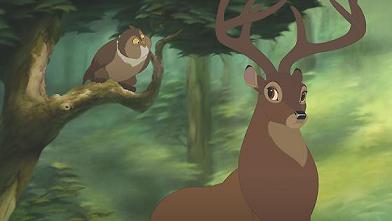
AV:What do you think traditional orchestral film music still has to tell us, at a time when many scores tend to be mostly electronic and non-thematic?
BB: I have absolutely nothing against synth scores, but in a movie like this, when one is trying to reconstruct an old musical and an old emotional style, one can really only do that effectively with acoustic musicians. I’ll give an example, which, though it may sound self-serving, really came as a surprise. My wife, Belinda, is my concertmaster. She has a big and very expressive sound. On the first day of recording, Matt Walker, the VP of music for DisneyToon Studios, asked if we could play a version of the theme for the head of the studio. I found a cue that happened to end with a short violin solo – certainly no more than 8 or 9 violin notes altogether. When we got to the violin solo, it was so emotional that a couple of people in the recording booth burst into tears. Try that on a synth!
AV:Action music in Bambi II seems rather remote from the original music in that regard. Can you tell me about that aspect of your score?
BB: One of the interesting things about the original Bambi is that, as I have mentioned, much of the dramatic score is very contemporary. Frank Churchill wrote the cute tunes, but the action music was composed by others. I took this as license to do the same on our action scenes. There are several places in which Bambi is in serious danger, when he is being chased by the hunters’ dogs. There is a particularly effective sequence when Bambi is in a meadow, surrounded by tall grass and the dogs close in on him. The music here isn’t too “Bambi-like”. Having said that, I was always aware that this score should sound as though it could have been composed in 1940. So the present day” feeling is tempered somewhat by that acknowledgment.
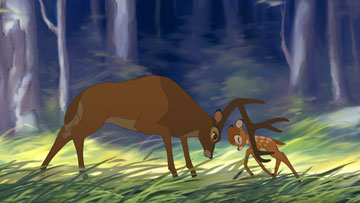
AV:Your score is very emotional in many ways.
BB: Because this score was done primarily in an old-fashioned style, I relied upon traditional elements, like melody and harmony, to project some emotion. I tried to fashion themes and phrases that were reminiscent of the romantic music from the 40s. I relied a little on some older techniques like string portamento – although today’s musicians resist it – to give some sentiment, and tried as much as possible to stay away from a click track so that the melodic lines, when necessary, would not be stiff. In general, there isn’t a lot of difference between emotion in live action and animation if the films are made correctly, and this one certainly was.
AV:And the emotion is present from the very beginning…
BB: The film opens in the aftermath of Bambi’s mother’s death, so the movie has a somber beginning. I refer to Love Is a Song in the first cue, as much to give the movie some relationship to the original as anything.
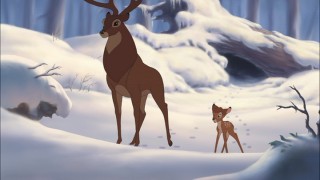
AV:How did you accompany Bambi throughout his emotional and personal journey?
BB: The character of Bambi doesn’t develop quite as much in this film as it does in the original. In the original film, Bambi comes to adulthood, but not in this film. This film has much to do with Bambi’s relationship with his father, the Great Prince. As Bambi gains confidence in himself, his father’s somewhat aloof attitude towards him starts to change as well. The film makes this point clearly, so there wasn’t anything that I had to do to help it along.
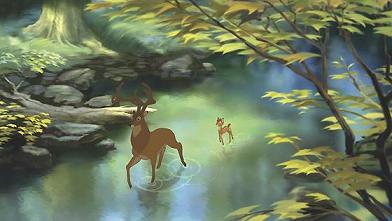
AV: How did you approach the father/son relation that is at the core of the movie?
BB: There is a Bambi/Great Prince theme that is used throughout. It’s often noble and sometimes moving. It is used in a variety of ways to express whatever is happening between the two of them. From the first time I saw the film, I thought that this was the strongest part of the story. It’s a very good and effective father/son film. Bambi wants his father’s attention and approval; his father tries to balance being “The Great Prince” with raising a young prince by himself.
AV:Can you tell me about your treatment of Ronno?
BB: Ronno gets his own theme, an insinuating motive that more or less worms its way into the rest of the music, much like Ronno does with the other characters.
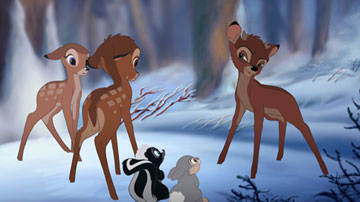
AV:And about your treatment of Faline?
BB: For this relationship, I went back to the 40s style, and wrote something very lyrical and expressive, that shows a little of the sweet naïveté and insecurity of the two beginners.
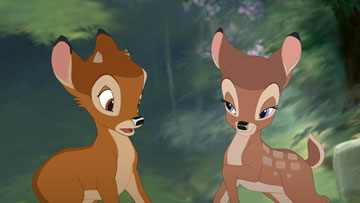
AV: Can you tell me about your other original themes?
BB: In some cases, the new movie has new and specific dramatic elements and required new material. For instance, there is The Brave March, a scene which for a while had an original song by me (which shows up in the album, though not in the score). The Brave March theme is used throughout the film, whenever Bambi is trying to be brave, a strong dramatic point in the movie.

AV:How did you integrate the arrangements of There Is Life and of First Sign of Spring within your score?
BB: I didn’t do these arrangements. Instead, I asked my friend Bill Elliott to do them for me. Stylistically, the songs have nothing to do with the score. I tried to be as graceful as possible getting into and out of the songs. But, stylistically, they’re very different from the score. In fact, all of the songs in the film, including the ones in the end credits, are stylistically dissimilar, even one from the other. There was no way I could think of to combine these styles with the style I was asked to do for the film. The songs were chosen and committed to before I got onto the film.
AV:How did you weave these themes into your score?
BB: Only two of the cues refer to the songs. One is when Bambi is temporarily “given away” to another doe to be raised, and the other is at the very end, as a long transition and intro to a final reprise of There Is Life.

AV:What relation did you conceive in your approach to 1942 songs and 2006 songs?
BB: The 1942 songs really were not as well developed as the songs in the new movie. But they were much more integral to the film, having been composed by Frank Churchill, who wrote the first score. Churchill’s score was amended later, after Disney felt that it wasn’t dramatic enough. But the Churchill themes were never touched. The 2006 songs are more of a modern day marketing tool, similar to what happens in contemporary feature films.
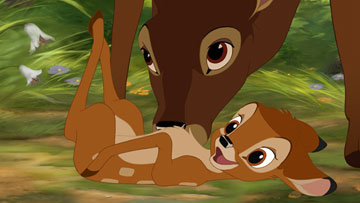
AV:Can you tell me about recording the score? How many sessions did it take to record the music, and what was the size of the orchestra compared to the original film’s “expanded pit band”?
BB: We recorded for four and a half days at Twentieth Century Fox’s Newman stage with Armin Steiner mixing, so it was a first class project from start to finish. Most of the score was recorded with an orchestra of either 76 or 60 musicians, and was reduced to about 45 for a half day. We also had a choir. The score was recorded entirely as a motion picture score.
AV:Can you tell me about your relation and collaboration with Matt Walker, the VP in charge of music for DisneyToon Studios?
BB: I can only say great things about Matt. He’s the only music executive I know in Hollywood who is really competent musically and dramatically (he has a substantial music education), who can read a score, produce it and make intelligently constructive remarks about the drama as well as the performance itself. As a manager, he heads a very effective department and has people working for him who are knowledgeable and function at a high creative and technical level. He’s also a very nice guy. He’s the best.
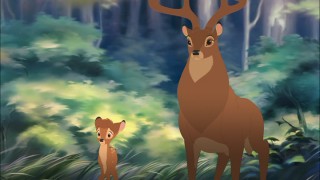
AV:From a personal point of you, were you particularly receptive to one or several topics treated in this film?
BB: I was taken with the father/son relationship in the film. Everyone I know who has seen it, especially those who are fathers, find it a very moving film.
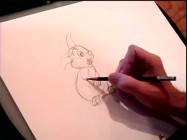
AV:What would be your conclusion on Bambi II?
BB: I’ve been told by people who have seen more of these films than I have that this is the best film that has come out of DisneyToons. It’s a very well made, very beautiful film to watch, and the performances are terrific. It works effectively on many different levels. It was very well directed, and very well produced.
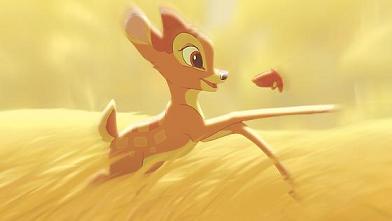
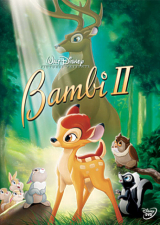

With all our gratitude and admiration to Bruce Broughton
- [Image]: http://www.amazon.com/Bambi-II-2/dp/B000B8QG3G?tag2=animatedviews-20
- [Image]: http://www.amazon.com/Bambi-II-2/dp/B000E0OF70?tag2=animatedviews-20
Source URL: https://animatedviews.com/2008/bruce-broughton-the-great-prince-of-bambi-iis-music/